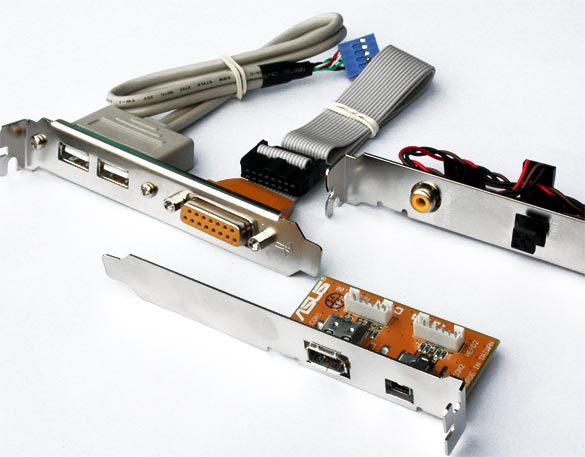The End User Pays: 13 Boards With Intel 845GE/PE
Asus P4PE/ GE: Now Fully Equipped At The Old Price, Continued
Both boards are fitted with a Soundmax 5.1 audio chip. Unfortunately, use of the 5.1 sound mode with analog output is difficult because a cable for the subwoofer and center box is missing. A highlight is the support for asynchronous memory speed of 178 MHz (for DDR355). This option leaves the Front Side Bus, PCI and AGP speeds unaffected, so that no specifications are infringed. A precise explanation of this function is given as part of the test. The AGP slot has an interesting solution for wrongly placed cards. If an old 3.3V graphics card (1x and 2x versions) is accidentally put in the slot, a red LED lights up when the board is switched on. Thanks to this protective mechanism, neither board nor graphics card is damaged. The voice output of errors at boot-up will be interesting to some enthusiasts. It saves a time-consuming search of the handbook for error codes. What should be positively mentioned is the Q-Fan feature that regulates the fan speed in BIOS. In addition, both boards have a Gigabit network controller that is almost standard on Socket 478 boards. That said, the customer can choose whether he wants a board with network output or not. After all, the chip pushes prices to the limit.
Still very costly: Broadcom's Gigabit network chip.
Besides the panels for USB 2.0, there's also a FireWire port and SP/ DIF for 5.1 audio.
A BIOS update turns out to be quite comfortable: using the Asus Update tool, the correct BIOS version is automatically downloaded from the Internet and updated under Windows XP with a mouse-click. That cannot be taken for granted with all the test candidates. The extensive equipment is augmented by the PC Probe tool. It displays voltage and fan speed and enables them to be adjusted. The Promise RAID controller deserves some criticism as it only has one IDE and two serial ATA ports. What the user doesn't know before he's bought it, though, is that the Promise controller is delivered with reduced software that refuses to run CD-ROMs. Help is at hand with a hacked BIOS, available from the usual sources. The two-phase voltage regulator supplying the CPU is no longer modern.
Get Tom's Hardware's best news and in-depth reviews, straight to your inbox.
Current page: Asus P4PE/ GE: Now Fully Equipped At The Old Price, Continued
Prev Page The Boards Next Page Asus P4PE/ GE: Now Fully Equipped At The Old Price, Continued
